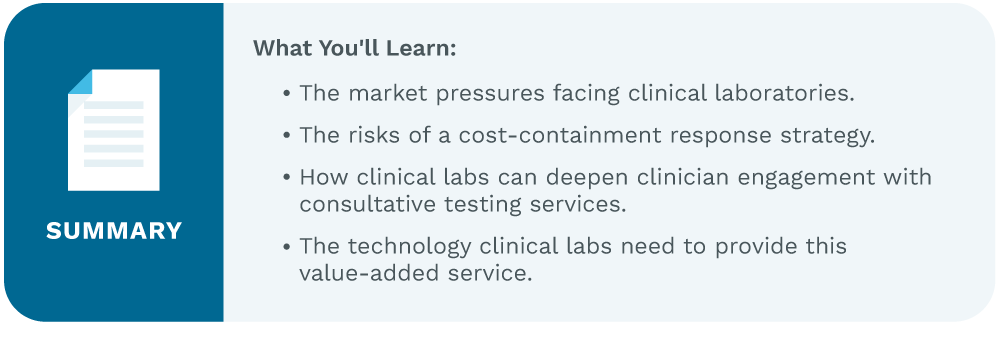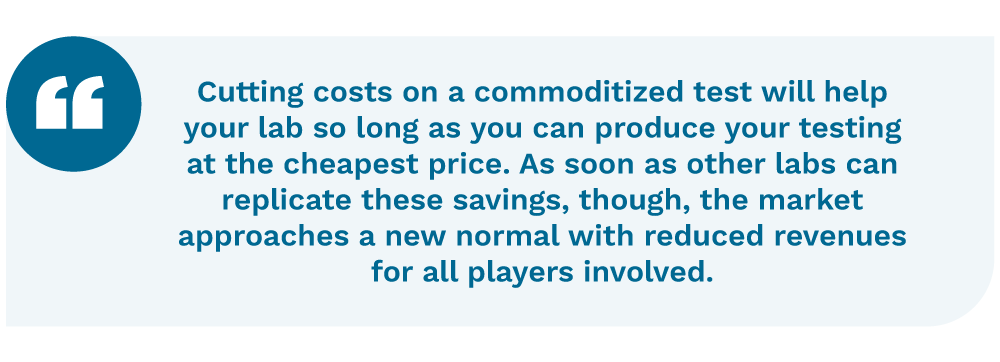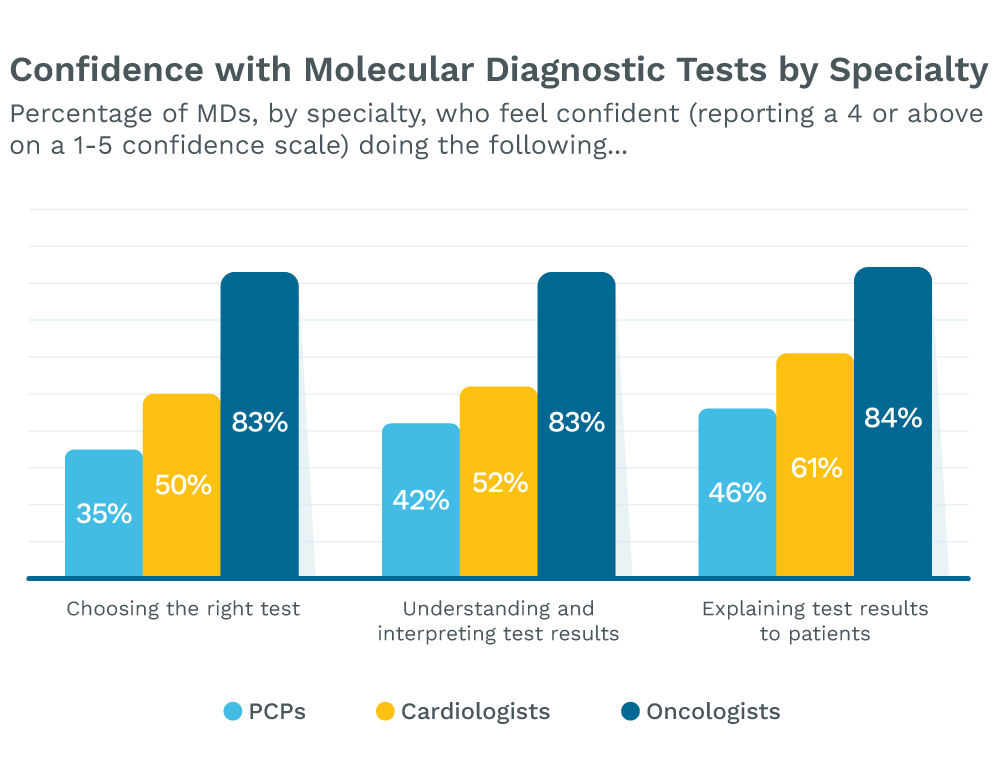 The healthcare landscape is changing considerably, and the market of clinical laboratory testing is shifting alongside it.
The healthcare landscape is changing considerably, and the market of clinical laboratory testing is shifting alongside it.
As healthcare costs rise overall, payers are increasingly demanding to know the value of laboratory testing — that the tests being performed are cost-effective. Hospitals and health systems, too, are seeking to reduce costs as their margins shrink. One area they’re looking at? Cutting down on tests that could be considered unnecessary.
All the while, laboratories are facing an “increasingly rigorous” regulatory environment. With all of these factors converging, some clinical laboratories are finding that “business as usual” cannot serve as their path forward. With mounting scrutiny from all sides, clinical laboratories are increasingly turning to technology to guide them forward in a changing market.
Like many organizations, these labs face two major options forward: cutting costs or providing increased value to their customers (clinicians). Either path allows them to benefit the clinicians they serve through ultimately reduced healthcare costs.
{{cta('2555101d-98c7-45cf-b33d-a4c7a20d705e')}}
The Risks of a Cost-Cutting Strategy
As G2 Intelligence noted, however, the decision to adopt a cost-cutting approach is a risky one. After all, labs can perform many standard tests on widely available instruments, so common laboratory tests are becoming increasingly commoditized. Managed care organizations now prefer to work with the labs that can reliably produce results at the lowest cost. These market realities turn the path of cost containment into a “Prisoner’s Dilemma” scenario, where multiple businesses making the same (seemingly profitable) decision ultimately puts everyone involved in a worse position overall.
Here’s why. Cutting costs on a commoditized test will help your lab so long as you can produce your testing at the cheapest price. As soon as other labs can replicate these savings, though, the market approaches a new normal with reduced revenues for all players involved. This approach presents fewer long-term opportunities.
 Providing Value-Added, Consultative Services in the Clinical Lab Space
Providing Value-Added, Consultative Services in the Clinical Lab Space
Instead, the recommended approach for labs involves a shift in focus: from cost containment to providing value-added services to clinicians, which help them realize benefits outside of the reduced costs on testing. The most effective way to do so? Consult clinicians on which tests to run and what the results mean. This approach goes beyond traditional clinical lab offerings, but data show that an opportunity exists in the field for these types of services.
For example, a study conducted by CAHG (part of Omnicom Media Group) in 2010 found that:
- Only 35 percent of PCPs felt confident (a 4 or above on a 1-5 confidence scale) choosing the right molecular diagnostic test for a patient. Meanwhile, only 42 percent felt confident interpreting these test results, and a mere 46 percent felt confident explaining test results to their patients.
- For surveyed cardiologists, these results were better but still low. Only 50 percent felt confident choosing the right molecular diagnostic test; 52 percent felt confident interpreting these test results; 61 percent felt confident explaining test results to patients.

It’s worth keeping in mind that these results are from 2010, but per Lab Testing Matters, this overall trend has held constant. In an article from 2015, they stated, “The laboratory test menu has expanded rapidly. Primary care physicians find it difficult to become familiar with the indications and result interpretation for the many tests available, as do specialized physicians for tests that are not specifically useful to their specialty.”
All of this information points to a knowledge gap in the current provider system — one that clinical laboratories are uniquely suited to fill. As the array of available tests grows and becomes more complex, the need will rise for lab professionals to advise doctors on which tests to run, interpret what their results mean, provide patient-specific narratives and offer relevant statistical data.
Ultimately, the goal isn’t just to protect margins in the clinical lab space — it’s to reduce costs elsewhere in the healthcare industry. According to Irwin Rothenberg, “Studies have shown the clinical and economic value of properly trained laboratory professionals who are truly expert in assisting attending physicians with test selection and interpretation.”
These advisory services can help physicians decrease the cost of patient care by reducing the number of unnecessary tests run, cutting down on unneeded clinical care and avoiding preventable mistakes in the care process. In doing so, patients receive better and more timely care, payers and providers save money, and the clinical lab transforms from a perceived cost of care to a value provider in the healthcare industry. Everyone wins.

The Technology Clinical Labs Need to Transform Their Offerings
Of course, this transformation is easier said than done. For a clinical laboratory to provide this sort of close, consultative support requires changes to its current processes and technology.
On the internal technology front specifically, to achieve the value offerings described above, clinical labs should consider implementing the following:
- A streamlined, tech-based accessioning process to increase their speed of service, reduce errors and collect data insights. Ideally, this should include the pre- and post-analytical phases. After all, more errors occur during pre-analytical processes — such as errors in specimen collection and labeling, incomplete test orders and more — than any other phase.
- A comprehensive service suite, capable of tracking all service requests and customer inquiries from multiple inbound channels (phone, email, etc.).
- Analytical tools capable of intelligently highlighting statistical trends that may be relevant to physicians, alongside patient-specific results.
- A clinician portal that allows them to log test orders, communicate with lab professionals, and/or securely access test results.
- Integrated technology that seamlessly combines all of the above into a comprehensive system.

Of course, not all of these pieces are immediately feasible, and not every lab will need all of them. The point, instead, is to understand the technological end state that makes the most sense for your lab and the value you’re trying to provide to clinicians. From there, the name of the game is working toward that goal gradually, adding first the pieces that will have the greatest impact on your teams and customers.
Ultimately, these efforts will net you loyal customers who view your lab as more than just a vendor — but instead as a valued partner in the care process. Failure to respond to the threats mentioned above, meanwhile, runs the risk of continued commoditization of your lab’s services in an increasingly cost-conscious market.
Interested in learning more? Check out our on-demand webinar telling the story of one healthcare lab’s technology transformation, which helped them go from spiral notebooks to thousands of cases closed electronically. It will give you even more insights into where your lab can take its technology next.



